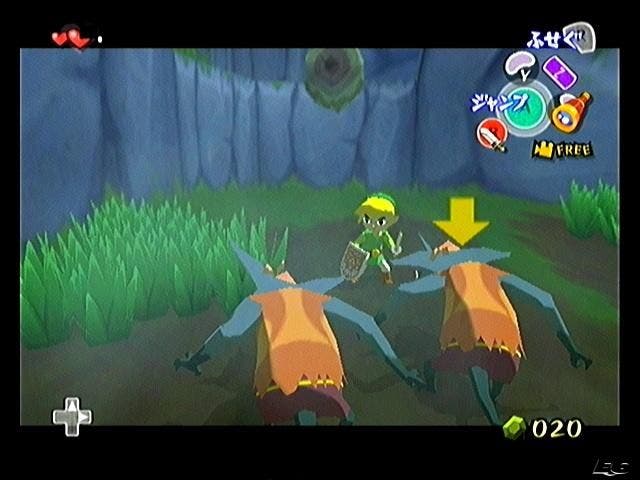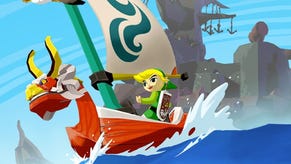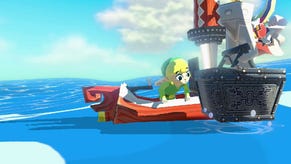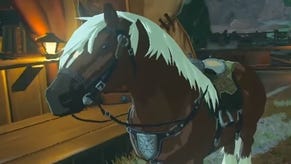The Legend of Zelda: The Wind Waker
Kristan spends the weekend on the high seas
We have to admit to being somewhat pleasantly surprised to take possession of the latest in the Zelda saga three days before its US release. But never one to look a gift horse in the mouth, we thought it was only fair to deliver our early thoughts on what stands as one of the most important games Nintendo has ever released. With large retail chains the UK over seemingly intent on deserting the GameCube less than a year into its lifespan, the Big N needs a huge hit on the format like never before.
Naturally, the game has already been a sizeable hit in Japan, selling around 700,000 units since its release three months ago, but crucially, just 180,000 new Cubes have sold in the territory since the turn of the year, suggesting that this is might be another case of preaching to the converted. Its fortunes in the US seem assured, though, with over 600,000 pre-orders reported, but will the European audience react with such fervour?
If games were sold on their looks alone, then The Wind Waker would surely be jostling for position near the front of the queue. A lot has been said about the decision to adopt a stylised, toon-shaded visual style, and not all of it's been positive - particularly among the aficionados, concerned at the ostensibly 'kiddie' look about it. But while it's true that you can't please all of the people all of the time, the sheer quality on show here should dispel any lingering doubts within a matter of seconds. Ever since the 8-bit era, publishers have been boasting "cartoon quality" graphics, much to our eternal bemusement and amusement, but it would be no exaggeration to say that Nintendo has pulled it off in some style. It's with some relief that developers are able to harness the power the current crop of machines in order to deliver games in a visual style we're not accustomed to; by using a bit of artistic imagination, Nintendo has breathed new life into the series.

Ice in your veins?
Link and friends have a curious big head-small body look about them, replete with enormous bug eyes and an almost complete absence of nose, but much of The Wind Waker's charm is as a result of the splendid animation and amount of expression that each and every character is given. Link himself has an array of endearing facial poses, ranging from flinty-eyed determination, to wide-eyed shock, while every person or creature you meet along the way seems to have their own party piece. If your face doesn't crack a smile at the sight of a snotty-nosed kid with a perpetually returning dangler, then you must have ice in your veins.
The one slightly disappointing aspect of the otherwise supremely polished visuals was the blurring effect on objects and scenery out of Link's immediate vicinity, which seems at odds with the crispness on display at all other times. It's a small point, but if you've got an extremely sharp, large TV, it's a peculiar effect.
Controlling your way around Link's world is largely unchanged from the two N64 adventures. Movement is controlled via the left stick, with the camera shifting dynamically to give the best view. Jumping occurs automatically, so you're best to line Link up with the C-stick, otherwise you end up careering off course, which isn't ever too much of a problem, seeing as you can jump off cliffs without incurring any damage. All manner of actions are performed with the A button, encompassing everything from opening doors and chests, and speaking to the many characters you encounter, to grabbing objects and throwing them, reading signs, and even handling some combat functionality. B, meanwhile, takes care of most of the combat duties, in conjunction with the L trigger. Crouching and defensive moves can be performed by holding down R, whilst X, Y, and Z can be assigned dynamically to whichever inventory item you decide.

The old kidnapped by a giant bird trick
The early section of the game acts as the usual 'glorified tutorial', so it's a case of guiding the birthday boy around the tiny island that he inhabits, talking to the weird and wonderful inhabitants, before getting hold of a sword and the traditional green costume. Once you've got yourself a sword and completed the brief combat tutorial you can then use your weapon to slash your way through the undergrowth and access the previously blocked suspension bridge section, at which point you can rescue the young lady pirate, Tetra, who had been mysteriously kidnapped by a giant bird. On the way back to their pirate ship, Link's sister Ayrll gets snatched by the bird, who mistakes the wee lass for the rather ungrateful Miss Tetra.
Realising that these birds are snatching young girls from all over the place, the mortified Link decides he has to take action, and joins the ramshackle crew aboard their ship. After a simple jumping tutorial, the crew then strap the unfortunate Link into a cannon and blast him to the sinister tower where the girls are being held captive. It doesn't quite go to plan, however, and not only is the trajectory all wrong, but the unfortunate Link drops his sword in the process. Under the cover of darkness, Link has to then stealthily make his way up to the top, dodging searchlights, sidling across narrow ledges, and occasionally getting thrown in the slammer if he gets caught.

Hit me with your Rhythm Stick
Back in daylight once again, the next sections give Link the chance to get to perform more traditional adventuring, chatting to the locals, playing Battleships-style mini-games, playing hide and seek with a bunch of unruly troublemakers, and attempting to track down a sail for his ship. Once equipped with this, the player can sail to his next destination; which is where the game starts to open up. Not only do you take possession of the Wind Waker for the first time, but also the 'Tingle Tuner' allowing you to try out the much vaunted GBA link-up.
The Wind Waker is basically a band conductor's baton that allows Link to perform magical actions if he waves it in the right direction, at the right time. Assigning the baton to either X, Y, or Z, Link can perform the 'song' in three time signatures: 3/4, 4/4 or 6/4, which are determined by the positioning of the left 'rhythm' stick. A Metronome bar appears at the top, and when the flashing yellow light hits the centre of the bar you must hit the direction required to perform the song, while holding the rhythm stick in the required direction. It probably sounds complicated, but it's no more so than your average rhythm-action game, and a neat way of performing special abilities.
The Tingle Tuner, meanwhile, is a means of giving the user an overhead map of your current island, as well a means of dropping bombs wherever Link may currently be located. You can call Tingle from areas where you have a map by pressing one of the item keys (X, Y, or Z), and guide him around with the GBA D-pad, call Link with the A button, use an item with B, or hit R to lock on to an enemy. While it's nice to have another use for our neglected GBA-GC link cable, it's to early to really judge whether this is a selling point as such, or just a nice novelty. Whatever, it's good to see Nintendo making some kind of effort.

Evolutionary
And that's about as far as we've got; too early to have really experienced any of the heavyweight sections, but deep enough to determine that it's got lorry loads going for it to justify the rave reviews and record breaking pre-order figures. If we were to compare it to other games out there, it feels even more like an adventure game than ever before, with several nods to classic LucasArts games such as Loom and Monkey Island more than apparent. In many respects, it feels like a serious, platform-lite Jak & Daxter (no bad thing), and won't take you much longer to finish, either, reportedly weighing in at a 15-20 hours completion time.
There's nothing drastically original about the game; from what we've seen The Wind Waker comes across as an extremely polished update of the previous two games, but given that both Ocarina Of Time and Majora's Mask are considered all time classics, that won't come as a disappointment to very many of you. We're loving what we've seen so far, but whether it will stand as a reason to buy the Cube is a question we'll be able to answer shortly before its May 3rd release date.









